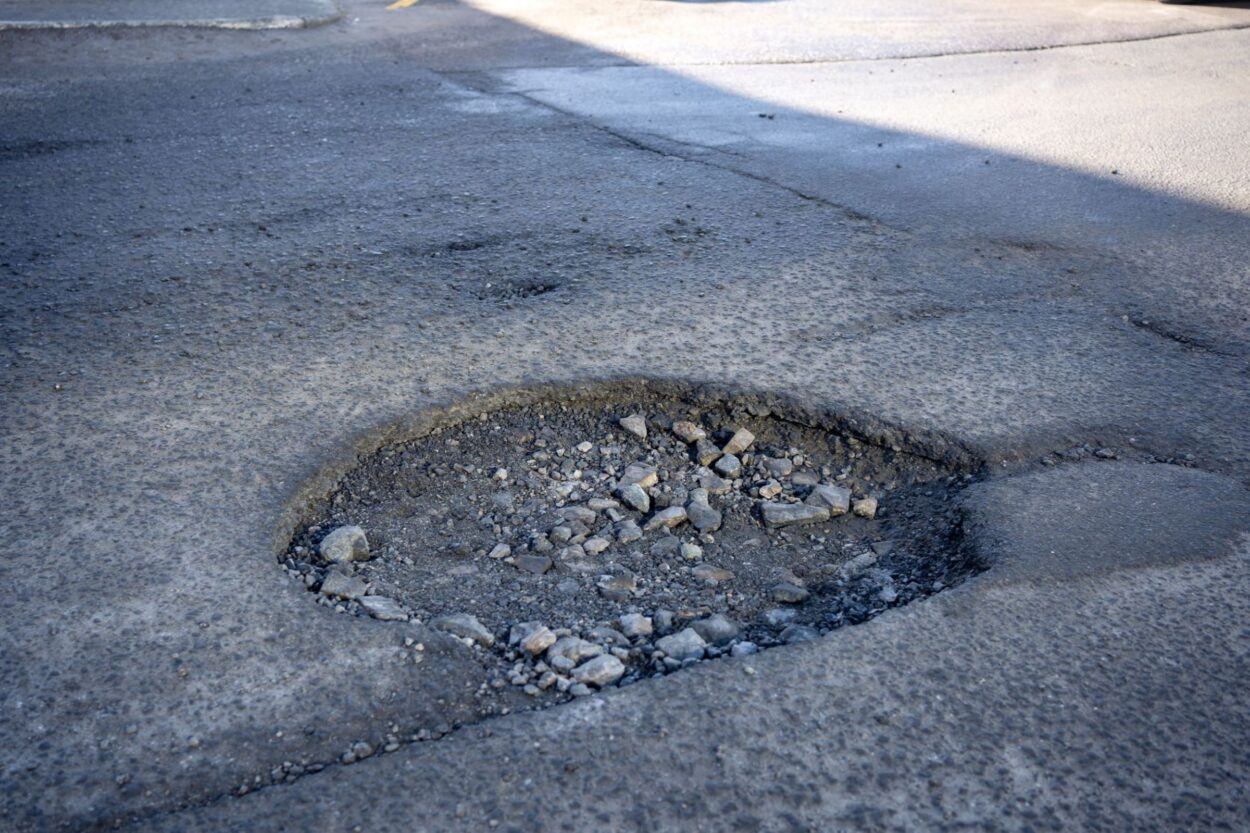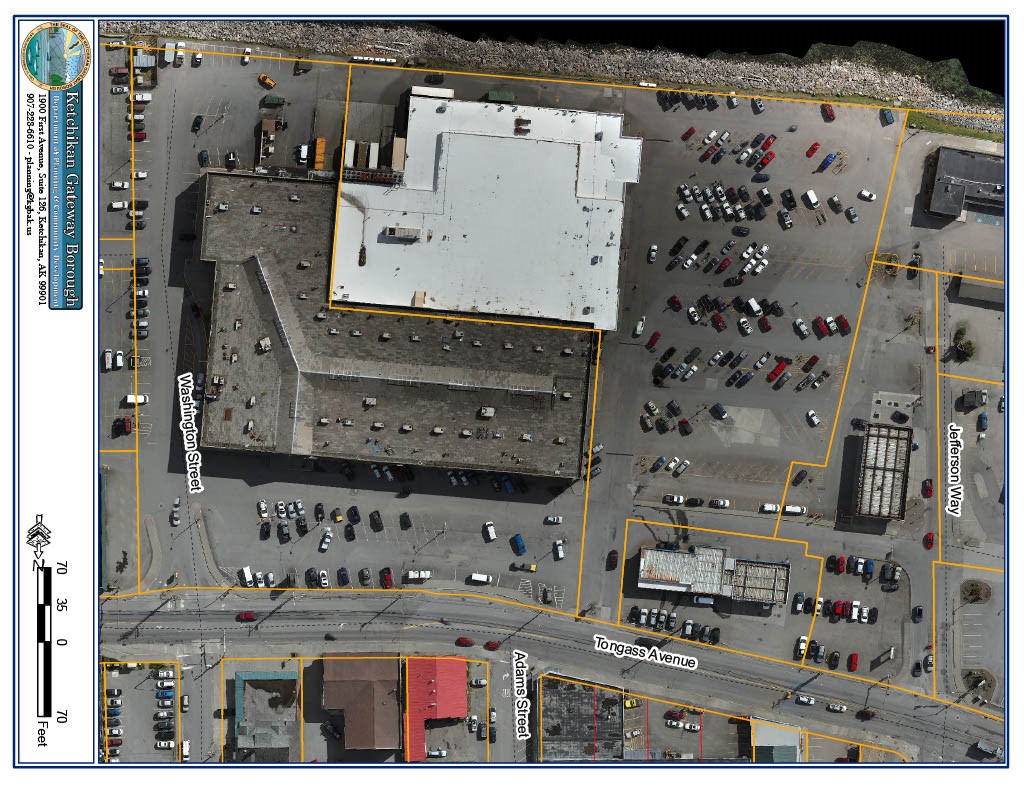
Ketchikan community members are complaining that their grocery runs are getting interrupted by potholes. And as the problem deepens, conspiracy theories are cropping up about why the city is slow to patch them. KRBD’s Jack Darrell set out to solve the municipal mystery.
If you’re headed to run errands in downtown Ketchikan, it’s likely you’ll drive down Tongass Avenue. And, at some point, you’ll turn towards the water – into one of the busiest parking lots in the city. And it’s likely that on the way in, you’ll hit a pothole.
In the shadow of the Plaza Mall, cars rattle over a stretch of pockmarked asphalt between a bank, an espresso shop, and the Safeway. The stretch is called Jefferson Way and to most, it may not look like anything at all. But to many Ketchikan residents, like Don Munhoven, it looks like a tumbledown purgatory of forgotten infrastructure — and a tire realignment.
“It’s not safe and someone should fix them,” says Munhoven from behind the counter of his lunch stand, Alava’s Fish-n-Chowder. He looks out at Jefferson Way as he fries fish for the lunch rush. “You’re forced to run over these potholes and they keep getting bigger and bigger.”
The question Munhoven and others are asking is this: why is one of the busiest stretches of asphalt in the city allowed to fall so far into disrepair?
Delilah Walsh is the Ketchikan City Manager and had a past life as a tax assessor. So, has she seen strange, seemingly isolated stretches of derelict road like this before?
“In every single community ever,” Walsh answers, laughing. She says the problem though is that it isn’t a public road. It isn’t a road at all. “Somebody does own that easement. There’s never this ‘owner-less piece of land.’
Walsh says Step 1 is to find out who owns it.
Jefferson Way is a private access easement. Meaning that the onus to repair it is on whichever business that owns it. And there are a few suspects – the bank, the marine supply store, the espresso stand, and the Safeway gas station and grocery.
But Walsh says it doesn’t have to be that way. The road could be maintained by the city. But there’s a catch. It would need to be brought up to maintainable standards. But that’s the problem in the first place.
“The real person to ask is the assessor’s office at the Borough. I’d get a parcel map from the assessor’s office and that’ll really say who owns this because that’s who’s responsible,” says Walsh.

The borough’s plat map is an aerial satellite photo of the area. Tongass Avenue runs up the side like a spine. Then there’s Jefferson Way, a dotted line in the upper corner, bisected many times over by orange. The private easement is the property of multiple businesses.
Which begs another question: is this bane of Ketchikan motorists just a platted stretch of commercial no-man’s-land? 150-odd feet of woodfill and asphalt that exists only in the far, cosmic reaches of its owners’ tax boundaries?
Amanda Robinson, the acting director of the city’s public works department, says that usually, where there is a shared easement, there is a legal agreement on file somewhere.
“It could be that it does not exist, but this is how it should be,” Robinson says. “When an easement is placed over multiple properties, there should be some kind of legal document that spells out who is responsible for what.”
According to Robinson, if that document exists, her counterpart at the borough, Morgan Barry, would know where to find it.
“Just from the outside looking in, there’s a lot of different parties,” Barry says over at the borough offices. He’s explaining that he isn’t aware of any legal documents, but he is familiar with the complexity of Jefferson Way. “And decisions have been made through the years that have led to that situation. And it’s very complicated.”
He’s right. The state records show the unassuming little easement has seen a host of replattings and changes-of-hands over the years.
Then – a lead. A local contractor named Brad Holm.
He says there is a legal agreement for the upkeep of the 150 foot stretch of asphalt that is Jefferson Way. Holm used to be a part of the organization overseeing it.
“But I’m no longer a part of it, really. So I used to be a president of it. But now I’m nothing,” Holm jokes.
Holm recalls that once, all of this property – everything the parking lot touches – was the kingdom of the Hames Corporation, a Southeast Alaska company that operates liquor stores and groceries in Sitka and Ketchikan. Then, when Hames Corp. started scaling back their Ketchikan operations after the pulp mill closed in the late ‘90’s, the land was subdivided. Holm bought some of it – what is now Cedar Point.
To manage the land, the businesses formed a nonprofit, and Holm says they have been trying for years to do exactly what city manager Delilah Walsh suggested.
“The idea is eventually to turn Jefferson Way into a public road. I mean, it should be. Everybody drives on that road,” says Holm.
And the large potholes that crowd the entrance? Turns out, they’re not a case of conspiratorial or bureaucratic corporate apathy. Holm says that stretch is outside of his ownership group’s jurisdiction.
“That’s actually the state of Alaska. Where those potholes are, that’s the highway. So that’s actually DOT, that should be fixing those,” Holm explains.
That fact was confirmed by the organization’s lawyer. As Holm puts it, the first yard or so of Jefferson Way, the part that’s in the worst shape, fits – administratively speaking – into the borders of the Tongass Avenue corridor. That corridor is part of the longest road on the island, which is considered a highway. So, it is under the dominion of the state.
“If you wanted to get that hole fixed, you’d have to complain to DOT. And DOT on a regular basis fixes potholes,” says Holm. “I wouldn’t be surprised if in the next few weeks they fix that. Because they’re aware that it’s there.”
Holm may be right. The infamous Jefferson Way potholes are likely not here to stay. The DOT unveiled their five year plan for Ketchikan last year. One of the projects, totaling up to $20 million, is improvements to Tongass Avenue. The projected deadline for completion is early 2025.
Until then, Ketchikan locals will have to put up with a few extra bumps in the road.
Get in touch with the author at jack@krbd.org.





